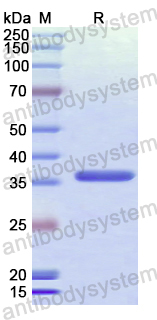Catalog No.
YHJ66401
Expression system
E. coli
Species
Homo sapiens (Human)
Protein length
Met1-Lys303
Predicted molecular weight
36.19 kDa
Nature
Recombinant
Endotoxin level
Please contact with the lab for this information.
Purity
>90% as determined by SDS-PAGE.
Accession
Q9NRQ2
Applications
ELISA, Immunogen, SDS-PAGE, WB, Bioactivity testing in progress
Form
Lyophilized
Storage buffer
Lyophilized from a solution in PBS pH 7.4, 0.02% NLS, 1mM EDTA, 4% Trehalose, 1% Mannitol.
Reconstitution
Reconstitute in sterile water for a stock solution. A copy of datasheet will be provided with the products, please refer to it for details.
Shipping
In general, proteins are provided as lyophilized powder/frozen liquid. They are shipped out with dry ice/blue ice unless customers require otherwise.
Stability and Storage
Use a manual defrost freezer and avoid repeated freeze thaw cycles. Store at 2 to 8°C for frequent use. Store at -20 to -80°C for twelve months from the date of receipt.
Alternative Names
PLSCR4, Cell growth-inhibiting gene 43 protein, PL scramblase 4, TRA1, Ca(2+)-dependent phospholipid scramblase 4, Phospholipid scramblase 4
Phospholipid Scramblase 1 Localizes Proximal to Sphingomyelin Synthase Isoforms but Is Not Involved in Sphingomyelin Synthesis., PMID:38866522
MiR-103-5p deficiency suppresses lipid accumulation via upregulating PLSCR4 and its host gene PANK3 in goat mammary epithelial cells., PMID:38583827
Identification of M2 Macrophage-Related Key Genes in Advanced Atherosclerotic Plaques by Network-Based Analysis., PMID:38194604
Bruck Syndrome: Beyond the Obvious., PMID:36476632
Phospholipid Scramblase 4 (PLSCR4) Regulates Adipocyte Differentiation via PIP3-Mediated AKT Activation., PMID:36077184
Whole blood transcriptomic analysis reveals PLSCR4 as a potential marker for vaso-occlusive crises in sickle cell disease., PMID:34772994
LINC00641 induces the malignant progression of colorectal carcinoma through the miRNA-424-5p/PLSCR4 feedback loop., PMID:33577029
Effect and mechanism of phospholipid scramblase 4 (PLSCR4) on lipopolysaccharide (LPS)-induced injury to human pulmonary microvascular endothelial cells., PMID:33569461
Identification key genes, key miRNAs and key transcription factors of lung adenocarcinoma., PMID:32642095
MitoQ regulates redox-related noncoding RNAs to preserve mitochondrial network integrity in pressure-overload heart failure., PMID:32004065
DNA methylation signature is prognostic of choroid plexus tumor aggressiveness., PMID:31409384
Long non-coding RNA LINC00641 suppresses non-small-cell lung cancer by sponging miR-424-5p to upregulate PLSCR4., PMID:31322545
Snail represses the expression of human phospholipid scramblase 4 gene., PMID:27363667
Biochemical and functional characterization of human phospholipid scramblase 4 (hPLSCR4)., PMID:23089641
Phospholipid scramblase expression in the pregnant mouse uterus in LPS-induced preterm delivery., PMID:22598484
A minimal nuclear localization signal (NLS) in human phospholipid scramblase 4 that binds only the minor NLS-binding site of importin alpha1., PMID:21690087
Calcium binding studies of peptides of human phospholipid scramblases 1 to 4 suggest that scramblases are new class of calcium binding proteins in the cell., PMID:19540310
The phospholipid scramblases 1 and 4 are cellular receptors for the secretory leukocyte protease inhibitor and interact with CD4 at the plasma membrane., PMID:19333378
Identification of Alix-type and Non-Alix-type ALG-2-binding sites in human phospholipid scramblase 3: differential binding to an alternatively spliced isoform and amino acid-substituted mutants., PMID:18256029
Phospholipid scramblase isoform expression in pregnant rat uterus., PMID:16979355
Adiposity, dyslipidemia, and insulin resistance in mice with targeted deletion of phospholipid scramblase 3 (PLSCR3)., PMID:15328404

